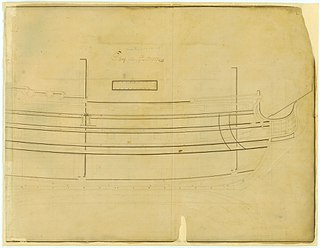
HMS Bellona was a 74-gun Bellona-class third-rate ship of the line of the Royal Navy. Designed by Sir Thomas Slade, she was a prototype for the iconic 74-gun ships of the latter part of the 18th century. "The design of the Bellona class was never repeated precisely, but Slade experimented slightly with the lines, and the Arrogant, Ramillies, Egmont, and Elizabeth classes were almost identical in size, layout, and structure, and had only slight variations in the shape of the underwater hull. The Culloden-class ship of the line was also similar, but slightly larger. Thus over forty ships were near-sisters of the Bellona." Bellona was built at Chatham, starting on 10 May 1758, launched on 19 February 1760, and commissioned three days later. She was the second ship of the Royal Navy to bear the name, and saw service in the Seven Years' War, American Revolutionary War and the Napoleonic Wars.
HMS Norfolk was an 80-gun third rate ship of the line of the Royal Navy. She was built at Southampton and launched on 28 March 1693, and was the first ship to bear the name. She was rebuilt at Plymouth according to the 1719 Establishment, and was re-launched on 21 September 1728. Instead of carrying her armament on two decks as she had done originally, she now carried them on three gundecks, though she continued to be rated a third rate.

HMS Princess Royal was a 90-gun second rate ship of the line of the Royal Navy, launched on 18 October 1773 at Portsmouth. During her career she was upgraded to a 98-gun ship, by the addition of eight 12 pdr guns to her quarterdeck.

HMS Elizabeth was a 74-gun third rate ship of the line of the Royal Navy, launched on 17 October 1769 at Portsmouth Dockyard.

HMS Eagle was a 74-gun third rate ship of the line of the Royal Navy, launched on 27 February 1804 at Northfleet.

HMS Princess Charlotte was a 104-gun first-rate ship of the line of the Royal Navy, built by Nicholas Diddams launched on 14 September 1825 at Portsmouth. The occasion was notable for the fact that the gates of the dry dock into which she was to be placed burst because of the high tide and more than 40 people were drowned.

HMS Swiftsure was a 70-gun third-rate ship of the line of the Royal Navy, built by Sir Anthony Deane at Harwich, and launched in 1673. By 1685 she had been reduced to a 66-gun ship.

The Prince Royal was a 55-gun royal ship of the English Royal Navy. It was later rebuilt and renamed HMS Resolution.
Repulse, sometimes written as Due Repulse, was a 40/48-gun ship of the English Tudor navy, launched in 1596.

Golden Lion was a ship of the English Tudor navy, launched in 1557. She was rebuilt for the first time in 1582.

President was a 38-gun fourth rate frigate of the Royal Navy, originally built for the navy of the Commonwealth of England by Peter Pett I at Deptford Dockyard, and launched in 1650.
HMS Duchess was a 90-gun second rate ship of the line of the Royal Navy, built by John Shish at Deptford Dockyard, and launched in May 1679.

HMS Ossory was a 90-gun second rate ship of the line of the Royal Navy, launched on 24 August 1682 at Portsmouth Dockyard. She was renamed HMS Prince in 1705.

HMS Humber was an 80-gun third rate ship of the line of the Royal Navy, launched at Hull on 30 March 1693.
HMS Ranelagh was a three-decker 80-gun third-rate ship of the line of the Royal Navy, launched at Deptford Dockyard on 25 June 1697. She took part in a number of actions during the War of the Spanish Succession, including the Battle of Vigo in 1702 and the Battle of Vélez-Málaga in 1704.
HMS Norwich was a 50-gun fourth rate ship of the line of the Royal Navy, launched at Deptford on 24 August 1693. The last of seven 50-gun ships ordered during 1692, she was given the name of Norwich following the loss of the previous 50-gun ship of that name on 6 October 1692.

HMS Mary was a 60-gun fourth rate ship of the line of the Royal Navy, built at Chatham Dockyard and launched on 12 May 1704.
HMS Swallow was a 60-gun fourth rate ship of the line of the Royal Navy, built by Peirson Lock to the dimensions of the 1719 Establishment at the Yard at Plymouth Dock, and launched on 6 October 1732. She was renamed HMS Princess Louisa in 1737.
HMS Strafford was a 60-gun fourth rate ship of the line of the Royal Navy, built to the 1733 proposals of the 1719 Establishment of dimensions at Chatham Dockyard, and was launched on 24 July 1735.

HMS Harwich was a 50-gun fourth rate ship of the line of the Royal Navy, built at King's Yard in Harwich by John Barnard to the dimensions laid down in the 1741 proposals of the 1719 Establishment at Harwich, and launched on 22 December 1743.













